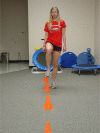Recent advances following anterior cruciate ligament reconstruction: rehabilitation perspectives : Critical reviews in rehabilitation medicine
- PMID: 22249750
- PMCID: PMC3535126
- DOI: 10.1007/s12178-011-9109-4
Recent advances following anterior cruciate ligament reconstruction: rehabilitation perspectives : Critical reviews in rehabilitation medicine
Abstract
Injuries to the anterior cruciate ligament are common. Surgical reconstruction is more prevalent than ever. This review article discusses treatment of the patient following surgical reconstruction of the anterior cruciate ligament. Various phases of rehabilitation are discussed with emphasis on early return of passive motion, early weight bearing, bracing, kinetic chain exercises, neuromuscular electrical stimulation and accelerated rehabilitation. Although evidence exists for the treatment of the surgically reconstructed cruciate ligament, more is needed to better define specific timeframes for advancement. Evidence exists that many of these young individuals are not fully returning to unlimited high level activities. This review article presents some of the latest evidence regarding anterior cruciate ligament rehabilitation in an attempt to help the busy clinician understand and relate basic and clinical research to rehabilitation of a patient following reconstruction.
Figures





Similar articles
-
Postoperative Rehabilitation of Anterior Cruciate Ligament Reconstruction: A Systematic Review.Sports Med Arthrosc Rev. 2021 Jun 1;29(2):63-80. doi: 10.1097/JSA.0000000000000314. Sports Med Arthrosc Rev. 2021. PMID: 33972483
-
Adding high-frequency transcutaneous electrical nerve stimulation to the first phase of post anterior cruciate ligament reconstruction rehabilitation does not improve pain and function in young male athletes more than exercise alone: a randomized single-blind clinical trial.Disabil Rehabil. 2019 Mar;41(5):514-522. doi: 10.1080/09638288.2017.1399294. Epub 2017 Nov 9. Disabil Rehabil. 2019. PMID: 29117738 Clinical Trial.
-
Variability in rehabilitation protocols following pediatric anterior cruciate ligament (ACL) reconstruction.Phys Sportsmed. 2019 Nov;47(4):448-454. doi: 10.1080/00913847.2019.1622472. Epub 2019 Jun 4. Phys Sportsmed. 2019. PMID: 31122097
-
Return to play after anterior cruciate ligament reconstruction.Clin Sports Med. 2004 Jul;23(3):395-408, ix. doi: 10.1016/j.csm.2004.03.004. Clin Sports Med. 2004. PMID: 15262378 Review.
-
Recent advances in the rehabilitation of anterior cruciate ligament injuries.J Orthop Sports Phys Ther. 2012 Mar;42(3):153-71. doi: 10.2519/jospt.2012.3741. Epub 2012 Feb 29. J Orthop Sports Phys Ther. 2012. PMID: 22382825
Cited by
-
OSTEOCHONDRAL ALLOGRAFT TRANSPLANTATION for the KNEE: POST-OPERATIVE REHABILITATION.Int J Sports Phys Ther. 2019 Jun;14(3):487-499. doi: 10.26603/ijspt20190487. Int J Sports Phys Ther. 2019. PMID: 31681506 Free PMC article.
-
Short-Term Outcome of Multi-Ligament Knee Injury among Sudanese Patients.Open Access Maced J Med Sci. 2019 May 15;7(9):1486-1493. doi: 10.3889/oamjms.2019.282. eCollection 2019 May 15. Open Access Maced J Med Sci. 2019. PMID: 31198460 Free PMC article.
-
Knee strengthening after orthopedics surgery: A comprehensive analysis using key performance indicators to Guide Physical Therapists.F1000Res. 2025 Jan 10;13:1118. doi: 10.12688/f1000research.156922.2. eCollection 2024. F1000Res. 2025. PMID: 40453703 Free PMC article. Review.
-
Graft Intra-Articular Remodeling and Bone Incorporation in ACL Reconstruction: The State of the Art and Clinical Implications.J Clin Med. 2022 Nov 12;11(22):6704. doi: 10.3390/jcm11226704. J Clin Med. 2022. PMID: 36431181 Free PMC article. Review.
-
Electromyographic activity of selected trunk, core, and thigh muscles in commonly used exercises for ACL rehabilitation.J Phys Ther Sci. 2018 Apr;30(4):642-648. doi: 10.1589/jpts.30.642. Epub 2018 Apr 20. J Phys Ther Sci. 2018. PMID: 29706723 Free PMC article.
References
-
- Cavanaugh J. Anterior cruciate ligament reconstruction. In: Postsurgical rehabilitation guidelines for the orthopedic clinician. St. Louis: Mosby; 2006.
LinkOut - more resources
Full Text Sources

